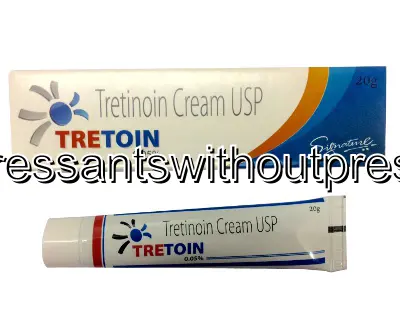Buy Tretinoin Online Without Prescription
| Package | Dosage | Price | Price per Dose | |
|---|---|---|---|---|
| Dosage: 0.1% | ||||
| 5 tube | 0.1% | $159.48 | $31.90 | |
| 4 tube | 0.1% | $140.34 | $35.09 | |
| 3 tube | 0.1% | $124.39 | $41.47 | |
| 2 tube | 0.1% | $92.49 | $46.26 | |
| 1 tube | 0.1% | $55.81 | $55.81 | |

Tretinoin Description
Overview of Tretinoin
Tretinoin, also known as all-trans retinoic acid, is a topical medication widely used in the treatment of acne and other skin conditions. It is a derivative of vitamin A and belongs to a class of compounds called retinoids. Tretinoin has been recognized for its effectiveness in promoting skin cell turnover and improving the overall appearance of the skin. Due to its proven benefits, it is a popular choice in dermatology clinics worldwide and is available through online pharmacies for convenient access.
Mechanism of Action
This medication works by stimulating the production of new skin cells while promoting the shedding of old, dead cells. This process helps to prevent the clogging of pores, a common cause of acne breakouts. Tretinoin also supports collagen production, which can reduce the appearance of fine lines and improve skin elasticity over time. Its ability to potentiate skin renewal makes it a versatile agent for managing various dermatological issues, especially acne vulgaris and hyperkeratosis.
Benefits and Effectiveness
Many users have reported noticeable improvements after consistent use of tretinoin. Acne lesions tend to decrease significantly, and existing spots often fade with prolonged application. In addition to acne treatment, tretinoin is occasionally prescribed for reducing signs of photoaging, such as fine wrinkles and age spots. Its effectiveness depends on proper application and patience, as visible results may take several weeks to become evident. Regular use also helps to prevent future breakouts and maintain clearer skin.
Usage and Application
Applying tretinoin correctly is essential to avoid irritation. Usually, it is recommended to use a pea-sized amount once daily at night, after cleansing the skin. Users should start with lower concentrations to assess skin tolerance. A thin layer should be spread evenly over the affected areas, avoiding sensitive zones like the corners of the nose and mouth. It is common to experience initial dryness, peeling, or redness. To minimize these side effects, moisturizing regularly and avoiding harsh skincare products are advised.
Possible Side Effects and Precautions
While tretinoin is effective, it may cause side effects, especially during the first few weeks of use. Common reactions include skin dryness, peeling, redness, and mild irritation. In rare cases, more severe reactions like swelling or blistering may occur. To reduce irritation, users should use sunscreen daily and limit exposure to sunlight. Pregnant or breastfeeding women are advised to consult healthcare providers before starting tretinoin, as its safety during pregnancy has not been fully established. It is also important to inform a doctor of any skin allergies or sensitivities before initiating treatment.
Conclusion
Tretinoin remains a cornerstone in dermatological treatments for acne and skin aging. Its ability to promote skin renewal and improve skin texture has earned it a reputation as an effective medication. When used responsibly and under guidance, tretinoin can deliver substantial benefits in achieving clearer, healthier skin. As with all medications, proper usage and awareness of potential side effects are vital for optimal results and safety.
See Also


